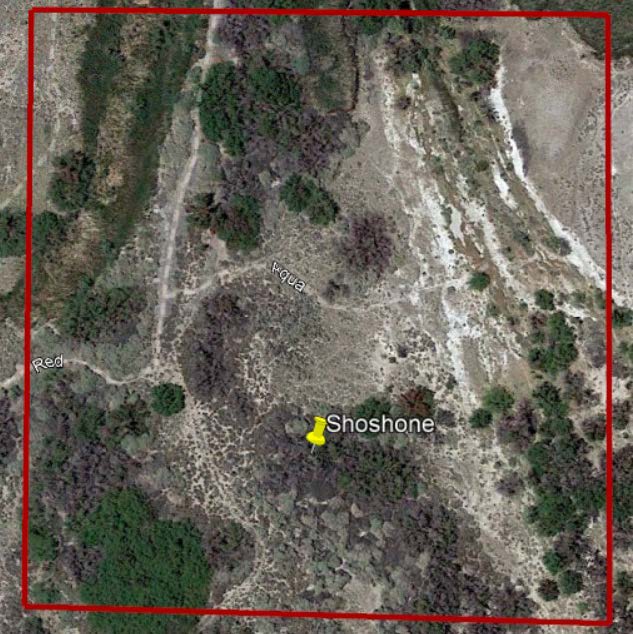DRI researchers are trying to solve the mystery of mass die-offs of screwbean mesquite trees, a critical part of their desert ecosystem
From above, the Southwestern U.S. is a sea of caramel and brown desert. Yet, a closer look uncovers small ribbons of green – desert forests that flourish along valuable springs and rivers. Wildlife thrives at these oases, drawn to the shade of trees that offer some respite from extreme temperatures. But in recent years, vast swathes of these forests have turned brown as trees died in high numbers. Scientists are puzzled by the die-offs and looking for answers.
In 2019, the Nature Conservancy invited researchers to a workshop focused on this question: what is killing screwbean mesquite trees? With corkscrew seed pods and compact, rounded leaves, the trees have found ways to survive amidst harsh desert conditions for millennia. Now, their patchy disappearance was alarming the teams working hard to conserve these desert ecosystems. Even now, four years later, scientists still don’t know what’s causing the decline.
DRI scientists Henry Sun, Ph.D., and graduate student Charlotte van der Nagel have been working to crack the case.

Photo credit: Henry Sun/DRI.
Screwbean mesquite trees: A vital part of sustaining life in the desert
A member of the pea family, screwbean mesquite trees are native to southwestern deserts and found in southern California, Nevada, Arizona, New Mexico, and parts of Texas and Mexico. They are typically found along desert streams where their roots can tap into the water table, enabling the trees to grow up to 30 feet tall. The tree’s spring blooms draw insects, which in turn provide food for migratory birds that time their migrations around the tree’s flowering. Birds like the endangered least Bell’s vireo use the trees for nesting, while many species (including humans) are attracted to the sweet bean pods.
Southwestern tribes like the Cocopah Indian Tribe utilize the tree for a wide range of purposes, turning the beans into cakes, syrup, and tea, and treating wounds with the root bark. Tribal elders were some of the first to notice the tree’s decline.
“There’s a lot of reasons we want to save this plant,” Sun says.


A Tree’s Struggle to Survive the Anthropocene
Scientists documented where the tree is found now and compared this data to the historic range of the plant, discovering that the screwbean mesquite is absent from more than half of its former range. In many places where it can still be found, fewer trees are growing.
The long-term decline of screwbean mesquite trees isn’t unique, as many forests that grow along streams and rivers have been impacted over time by human development. Excessive livestock grazing, the damming of rivers, and clearing for agriculture are just a few of the many forces acting against their favor. The spread of invasive salt cedar trees, or Tamarix, which compete for the same space and resources, has also taken its toll.
However, set against this gradual dip in mesquite tree populations are recent and dramatic deaths of groups of trees which occur suddenly and without a clear cause. Organizations like the Nature Conservancy have been working to restore these southwestern forests by removing Tamarix and planting native trees like screwbean mesquite. As they monitored their restoration efforts, they noticed, repeatedly, that large clusters of trees were rapidly dying in forests across the region. Scientists have produced theories ranging from disease, to higher nighttime temperatures, to methods used to control the spread of Tamarix trees, but no clear consensus has emerged.
“What is responsible for the die-offs? It’s a mystery,” Sun says. “And that’s where we started.”

Probing the Data for Answers
Fortunately, Henry Sun is a scientist who likes to follow mysteries, leading him to explore a wide range of scientific fields and questions. With degrees in botany, phycology (the study of algae), and microbiology, followed by postdoctoral work in astrobiology, he is always looking for ways to answer questions that fall between the cracks of scientific fields, he says.
Sun’s first step in cracking the case was to pinpoint when exactly the trees died, so he worked with his graduate student, Charlotte van der Nagel, to peek into the past.
“We knew from talking to biologists at the 2019 Nature Conservancy workshop that the event must have occurred after 2005,” Sun says. “But we really needed to narrow it down to a specific year.”
Charlotte dug into the historical satellite imagery available through Google Earth to look at the locations where mesquite trees died in high numbers. Starting with the patches of dead, brown trees at Ash Meadows National Wildlife Refuge, she turned back the clock each year until the trees showed leafy and green. This showed the researchers that the trees died between 2010 and 2011.


“What happened around that timeframe? This was when a drought cycle ended,” Sun says. “In other words, the plants went through drought and when the moisture came, they didn’t like it.”
Around the year 2000, the region started moving away from the conditions considered “average,” to an even drier climate. The winter of 2010-2011 brought a brief reprieve from the drought.
“So, what happened? How does drought make these trees sensitive to inundation?” Sun asks. “Being a floodplain plant, they should be resistant to inundation. What happened during the drought to change this?”
He looked to the plant’s physiology for clues. The roots of the screwbean mesquite tree grow deep enough to tap into the moist soil just above the water table, where they can access two things they need for the plant to flourish: moisture from below, and oxygen from above.
Sun and Charlotte dug up dead mesquite trees to examine their root systems, finding that trees that established during the drought had developed a thick, bark-like layer over their taproots. This layer helped the trees to survive sustained exposure to the hot and dry conditions, but Sun hypothesizes that it may also have doomed them when the rains came, showing a vulnerability to climate whiplash.

“If the drought conditions continued, these trees would have been fine,” Sun says. “They wouldn’t be happy, but they also wouldn’t die.”
When the drought ended and the water table rose, it submerged the deeper taproots in oxygen-deprived groundwater. The roots near the ground surface were closer to surface water from rainfall, which is oxygenated, but their thick, protective layer prevented them from producing the root hairs needed to access it.
“So, they need to grow, and they need water, but they can’t have water because the entire root system is shut down,” Sun says.
Supporting his theory, Sun points to mesquite trees in Arizona that survived this same period. This could be due to the summer rains, or monsoon season, that Arizona typically experiences. Perhaps the extra moisture in the summer eased the effects of drought, he says, so that mesquite trees there didn’t need to grow the same thick root skin.

If this is what caused the tree mortalities, why haven’t mesquite trees returned to these areas in the more than 10 years since? Sun suspects that the roots of all the dead trees have created a sort of “dead zone” around them as they decompose. This process consumes oxygen from the soil, making it impossible for new trees to establish.
“The entire area has become anaerobic – there’s water, but no oxygen,” Sun says. “You can try to restore these areas by planting trees, but they won’t survive.”

He found additional evidence of this theory by digging through the scientific literature, discovering that measurements from groundwater wells in the region showed a redox potential below the historical average (signifying lower oxygen levels in the soil).
Interestingly, new mesquite trees in Ash Meadows National Wildlife Refuge have been able to establish away from the dead trees, providing more support for his theory.

Although Sun says he feels confident in his research up to this point, he acknowledges that there are still gaps that need to be filled. “We need to do that quickly to save this critical tree,” he says. “We are racing against the clock of climate change. The Nature Conservancy and federal land managers are waiting to begin work to restore these desert ecosystems.”


